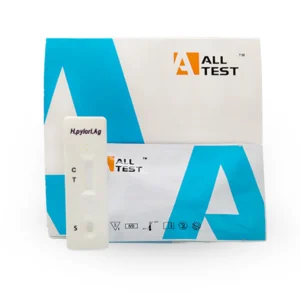27,77 PLN
29,99 PLN (incl. 8%VAT)
231,47 PLN
249,99 PLN (incl. 8%VAT)
Work efficiently, order profitably!
Place wholesale orders at info@bisaf.pl
Availability: In stock
H. pylori antigen test is a rapid immunochromatographic test for qualitative detection of antibodies to Helicobacter pylori bacteria in stool samples. The test comes in a convenient bulk pack of 25 units and is intended for use as an aid in the diagnosis of H. pylori infection.
H.pylori is a small spiral-shaped bacterium that lives on the surface of the stomach and duodenum. It is involved in the etiology of various gastrointestinal diseases, including duodenal and gastric ulcers, non-ulcer dyspepsia, and active and chronic gastritis. Studies have shown that more than 90% of patients with duodenal ulcer disease and 80% of patients with gastric ulcer disease are infected with H.pylori.
The high sensitivity and specificity of this test allow for reliable and accurate results, which are obtained in as little as 10 minutes!
The product is intended for professional use.
This is a medical device. Use it in accordance with the instructions for use or the label.
Our test is ideal for professionals in various fields, especially internists, dermatologists, pediatricians, for whom it can be helpful in:
Note: to make the test performed as reliable as possible, the test should be stored in a dry place at 2-30°C and used before the expiration date. Do not drink, eat or smoke in the area where the sample is stored and the test is performed, as this may affect the result obtained. Make sure to bring the sample, cassette and buffer to room temperature (15-30°C) before performing the test.
1. Take enough feces (1-2 ml or 1-2 g) into a clean, dry sample container. Best results will be obtained if the test is performed within 6 hours of collection. Collected samples can be stored for 3 days at 2-8°C if not tested within 6 hours. For long-term storage, samples should be kept below -20°C.
2. To process fecal samples:
For solid samples: Unscrew the cap of the sampling tube, then randomly poke the sampling applicator into the stool sample at at least 3 different locations to collect about 50 mg of stool (equivalent to 1/4 of a pea grain). Do not scoop the fecal sample.
For liquid samples: Hold the dropper vertically, aspirate the fecal samples, and then transfer about 80 μl into a sampling tube containing an extraction buffer. Tighten the cap on the sampling tube, then shake the sampling tube vigorously to mix the sample and extraction buffer. Let the tube stand for 2 minutes.
3. Remove the test cassette from the foil package.
4. Open the tube, then invert it and transfer 2 full drops of extracted sample (about 80 μl) into the sample well (S) of the test cassette, then start the timer.
5. Read the result after 10 minutes. A result read after 20 minutes is invalid.
EAN Code: 6970277511049
| Manufacturer | Authorized Representative | Importer / Distributor |
| Hangzhou AllTest Biotech Co., Ltd 550, Yinhai Street, Hangzhou Economic & Technological Development Area 310018 Hangzhou China css21@alltests.com.cn +86 57156267147 www.alltests.com.cn |
MedNet EC-Rep GmbH Borkstrasse 10 48163 Muenster Germany birthe.harms@mednet-ecrep.com +49 2513226661 www.mednet-ecrep.com |
Bisaf Sp. z o.o. Rdestowa 5 54-530 Wrocław Polska 24h@bisaf.pl +48 503411527 www.bisaf.pl |
27,77 PLN
29,99 PLN (incl. 8%VAT)
462,78 PLN
499,8 PLN (incl. 8%VAT)
26,84 PLN
28,99 PLN (incl. 8%VAT)
775,00 PLN
837 PLN (incl. 8%VAT)
#ARG! PLN
34,99 – 148,99 PLN (incl. 8%VAT)
Company
 Helicobacter pylori test | 25 pieces
Helicobacter pylori test | 25 piecesAvailability: In stock
Twoja wiadomość została do nas dostarczona i skontaktujemy się z Państwem w ciągu 1 dnia roboczego.